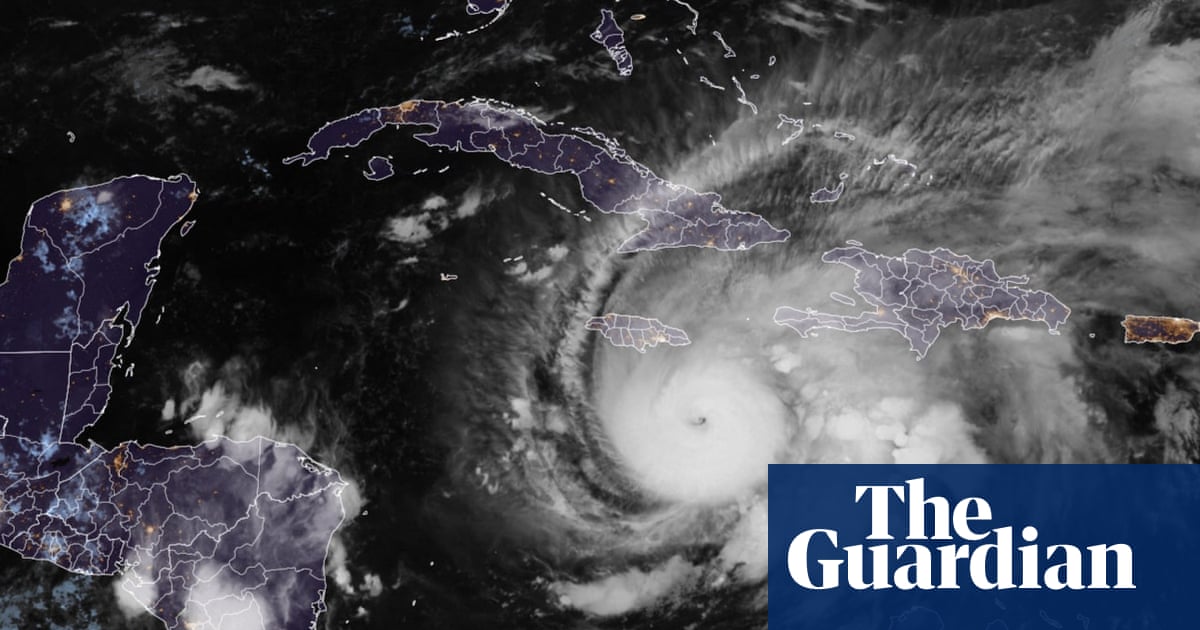Hurricane Melissa strengthens to category 4 as evacuations ordered in Jamaica’s capital | Hurricanes

Hurricane Melissa strengthened into a powerful category 4 hurricane on Sunday, threatening days of catastrophic winds and rain in the northern Caribbean, while Jamaica’s government ordered mandatory evacuations for vulnerable areas across the country including in the capital, Kingston.
Jamaican officials had earlier urged those in low-lying and flood-prone areas to seek refuge as Melissa rapidly climbs up the Saffir-Simpson hurricane wind scale with the possibility of intensifying to a category 5 storm on Sunday night.
During a press conference in Kingston on Sunday, Jamaican authorities said both international airports were closed and 881 shelters had been activated.
“Many of these communities will not survive the flooding,” said Desmond McKenzie, the minister of local government. “Kingston is extremely low. No community in Kingston is immune.”
Jamaica’s prime minister, Andrew Holness, later ordered mandatory evacuation orders for Port Royal in Kingston and six other vulnerable areas across the country including Old Harbour Bay.
Holness said earlier: “I urge Jamaicans to take this weather threat seriously. Take all measures to protect yourself.”
Melissa was centred about 125 miles (205km) south-southwest of Kingston, Jamaica, and about 310 miles (495km) south-southwest of Guantánamo, Cuba, on Sunday night. It had maximum sustained winds of 145mph (230km/h) and was moving west at 5mph (7km/h), the US National Hurricane Centre said. It could reach category 5 strength on Monday with winds greater than 157mph (250km/h).
Melissa was expected to drop up to 30 inches (76cm) of rain on Jamaica and southern Hispaniola – Haiti and the Dominican Republic – according to the hurricane centre. Some areas may see as much as 40 inches (1 metre).
The combination of rapid intensification and snail-paced advancement is a recipe for a catastrophic, record-breaking natural disaster, experts said. In its increasingly grim updates, the hurricane centre warned that extensive damage to infrastructure, power and communication outages and the isolation of communities in Jamaica were to be expected.
Some residents in the small fishing village of Port Royal, one of Jamaica’s most exposed and vulnerable communities, refused to heed official advice to leave their homes and take cover in shelters.
Residents such as Ann Marie Chamberlain, 51, decided to ride out the storm at home. She said villagers were confident they had done everything necessary to avert danger, adding: “Father God will protect us.”
Chamberlain, who is self-employed, said: “We know danger and we know when we are in danger and right now we are not. All the boats have been pulled up, the roofs with zinc have been battened down … we are taking the necessary precautions.
“The main reason we refuse to leave Port Royal is because of an experience 21 years ago. We went to the shelter, the first night was fine when it was just us, but then when other people started coming all hell broke loose. Females weren’t safe, and to top it off people stole our stuff. You would go to sleep and when you woke up your radio, money and other belongings [were] gone.”
Derrick Powell, 42, a marketing manager, echoed her sentiments. He said: “I have never been to a shelter but residents who have been say they will never go back.
“Everybody is already preparing, we know what it is like. We have heard about Hurricane Charlie. I experienced Gilbert and all the other storms … We don’t have any gullies or river to burst its banks. If a little water come up it’s maybe a few but by the time the rain ends it disappears.”
When Melissa leaves Jamaica it is expected to head towards Cuba by late Tuesday, where it could bring up to 300mm of rain, before moving towards the Bahamas late on Wednesday.
The Cuban government on Saturday issued a hurricane watch for the provinces of Granma, Santiago de Cuba, Guantánamo and Holguin.
The erratic and slow-moving storm has killed at least three people in Haiti and one person in the Dominican Republic, where another person remains missing.
Jamie Rhome, the hurricane centre’s deputy director, said: “Unfortunately for places along the projected path of this storm, it is increasingly dire.” He said the storm would continue to move slowly for up to four days.
In Haiti there were reports of rising river levels, flooding and a bridge destroyed due to breached riverbanks in Sainte-Suzanne, in the north-east.
Ronald Délice, a Haitian department director of civil protection, said: “The storm is causing a lot of concern with the way it’s moving.” Local authorities have organised lines to distribute food kits. Many residents are still reluctant to leave their homes.
The storm has damaged nearly 200 homes in the Dominican Republic and knocked out water supply systems, affecting more than half a million people. It also downed trees and traffic lights, set off a series of small landslides and left more than two dozen communities isolated by flood waters.
The Bahamas department of meteorology said Melissa could bring tropical storm or hurricane conditions to islands in the south-east and central Bahamas and the Turks and Caicos Islands by early next week.
Melissa is the 13th named storm of the Atlantic hurricane season, which runs from 1 June to 30 November. The US National Oceanic and Atmospheric Administration had predicted an above-normal season with 13 to 18 named storms.
The Associated Press writer Evens Sanon in Port-au-Prince, Haiti, contributed to this report.
Source link

